 |
||||
|
||||
| The Layout | ||||
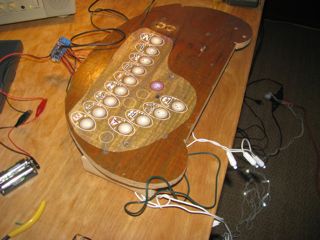 |
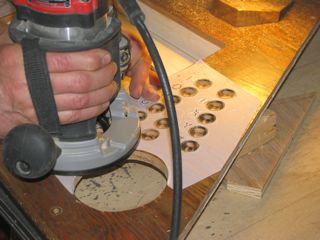 |
|||
| A mockup to test the concept: press a button and the TARDIS will audibly translate a letter for you. Oval cartouches with letter-and-code combinations are to be lit with 30 holiday LED lights (one of many such strings in the TARDIS, a gift from Oma/Vic) | After finaizing the button layout (designed on computer & printed out), we used a rounter to accurately locate the recesses through the paper template, to make membrane switches and mini-wells for the lights. | |||
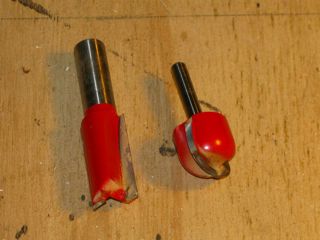 |
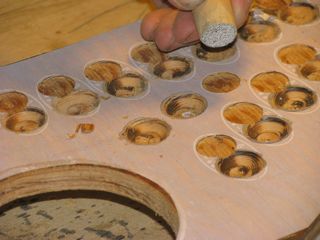 |
|||
Router bits: Flat bottom for membrane switch; round bottom for the lights |
Cleaning up the recesses with sandpaper; each letter has a corresponding light, | |||
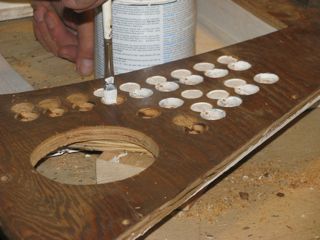 |
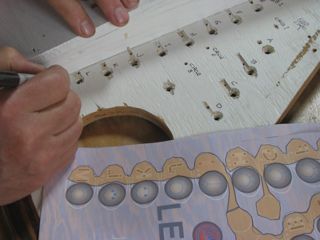 |
|||
| Painting the recesses on the top for good light-spread; then on the underside… | carefully mapping the letter- and wiring-connections to coordinate with the sound cards. | |||
| The Electrics, Lower Part | ||||
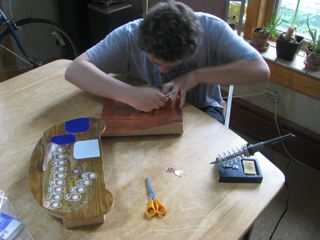 |
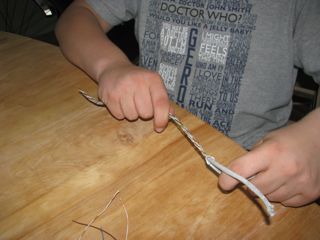 |
|||
| Cyrus is using a coin to trace onto a sheet of copper the outlines of several dozen membrane switches. | Stripping the cover off of scrap lengths of Cat5 (ethernet) cable to use the thin copper wires inside. | |||
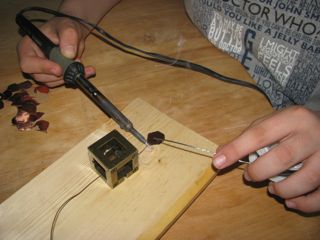 |
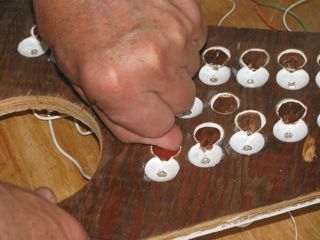 |
|||
| Soldering the wires to the rounds of copper sheet. Next step is to place them into the routed depressions and burnish them down. | The copper sheet has an adhesive backing; it's actually sold for making the soldered outlines in Tiffany-style stained glass. | |||
| The Electrics, Upper Part | ||||
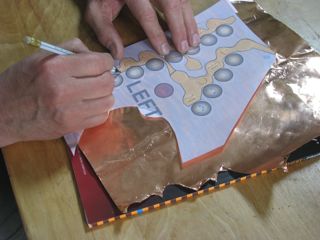 |
 |
|||
| Enscribing the copper sheet over a soft magazine… | then cutting out the shapes. | |||
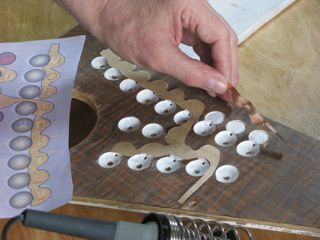 |
 |
|||
| Checking fit and adjusting small details of shape, to ensure that each switch will function. Once the copper sheet is adhered, of course it's too late to change. | The final design uses tough plastic sheet (used in making back-lit signs) for the top membrane, discovered at the shop where we have our architectural renderings printed. | |||
| The Assembly | ||||
 |
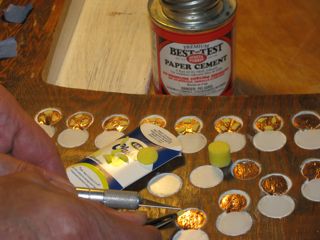 |
|||
| Hot-gluing the light difusers made from scrap styrene covers of a fluorescent fixture. The Matrix is intentionally a little counter-intuitive; althoughit it is lighted, you must press the letters, not the lights themselves. | We experimented with different means of keeping the two contacts seprated until fingers apply pressure; string, snips of plastic onion bag netting etc. We settled on little chunks of stiff foam ear protectors. | |||
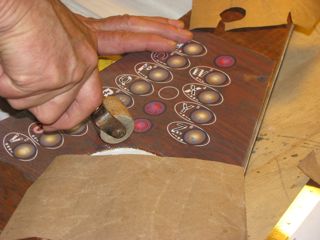 |
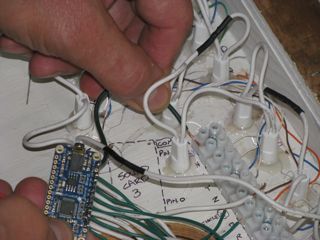 |
|||
| Gluing down the membrane after careful alignment of the plastic sheet. After testing several types of glues, we found TiteBond laminate adhesive to be most successful. | Testing a sound board. Three tiny sound-FX boards (from the excellent Adafruti website) each have 11 trigger pins and memory for a hundred-odd short, pre-recorded audio files — enough for the alphabet, some snide buttons for fun, and some 'secret messages' to discover. | |||
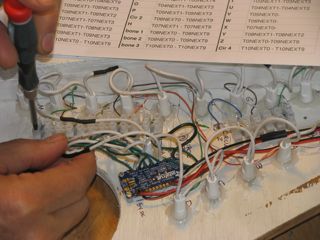 |
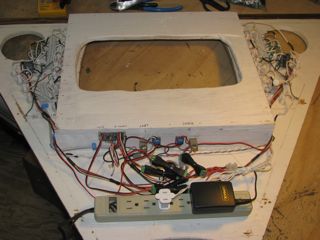 |
|||
| The button wiring shares space with the LED holiday lights hot-glued into their wooden sockets. Carefully pre-planning the sound files (on the printout) helped in correctly mapping the sound card pins with the corresponding letters of the alphabet. | View of the rear of panel, with Matrix wiring completed. The power strip has been hacked; it will be remotely switched via a latching relay when players reach the appropriate point in the game-play and succeed in turning on the Matrix and typewriter. | |||
The Dreampitcher The genesis was an idea of Day's: a working phone somewhere on the console and a remote voice actor, so one could communicate with the TARDIS in realtime. This has evolved into the DreamPitcher, a telepathic 'helpline' that the children must discover and activate using the correct switches. |
||||
 |
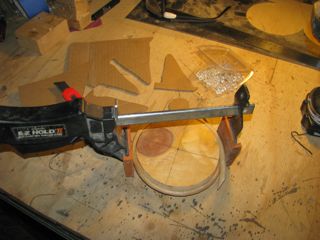 |
|||
| I began mocking up the shape of the support frame by tracing my hand onto cardboard, to lend this element an anthropometric quality. Then I cut the shape from steel plate and bent the 'fingers' to cradle the wooden hoop. | Gluing up a thin, green-wet willow branch from a nearby wetland to form the small hoop of the DreamPitcher. The flexible stalk from a Goodwill table lamp allows adjustment of the DreamPitcher to a comfortable height. | |||
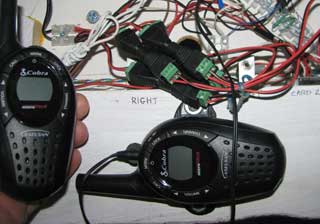 |
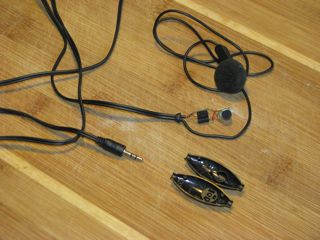 |
|||
| These Cobra walkie-talkies are eBay-bought, new but at small fraction of the retail price because the charger was wired for European sockets. Easily fixed. | Hacking the headset for the mic and to take advantage of the muting circuitry. This was a matter of re-directing the switching to a DPDT rocker on the Navigations panel. | |||
(above) The delicate walkie-talkie microphone will be concealed within the DreamPitcher. (at right) Decorative dangling strings are made from old resisters and capacitors, and feathers that Day found on one of her wild-crafting walkabouts. |
|
|||
| Listening to the TARDIS speak directly is "telepathic" : a traditional dreamcatcher's central spider-bead is here replaced by a 'bone inducer' mounted on springs like an old fashioned condensor microphone. When the inducer is pressed against the forehead, sound is trasmitted through the skin into the bone. Eerily, you hear sound inside your head, not through your ears. | ||||
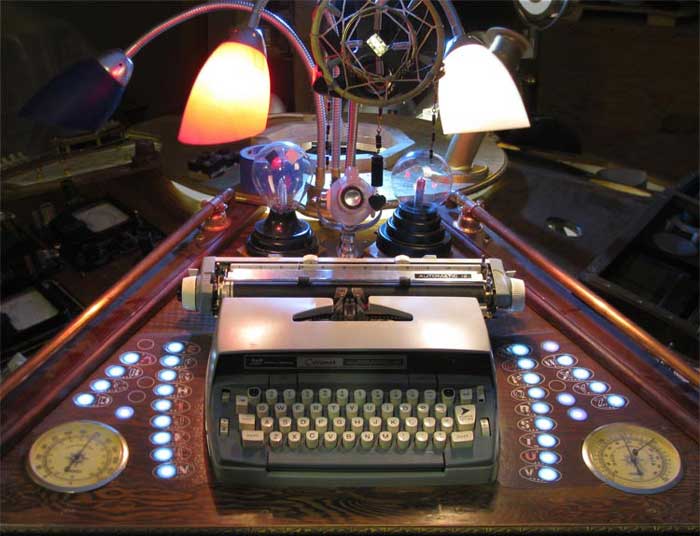 |
||||
(above) The Communications panel mostly complete. The TARDIS ' pre-recorded hints and jibes emerge from an unusual orb speaker scrapped out of an old iMac. Extras such as the glowing plasma globe, radiometer and backlit dials for barometric pressure and humidy add ambiance and may figure into the game-play. Each letter and some dipthongs are placed within lozenge shaped cartouches. Letters of the Latin alphabet with graphic equivalents in Morse-code and Gallifreyean (the primary language of the show's main character) plus a number code for each letter that will figure in translations for the game-play. The plastic membrane is photo-matched to the wood console finish only imperfectly, but good enough. Lessons learned: The membrane switches are mostly successful, but after the full feel and function is apparent, a bit too much pressure is needed to operate some switches. Next time I might investigate using small tactile switches under the membrane instead of copper contacts, tho' that solution would come with it's own installation issues. As with other elements, I hope the usability and game-play will be worth the effort of the fabrication. |
||||

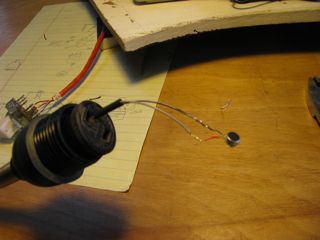

 Comments? lou@designcoalition.org
Comments? lou@designcoalition.org